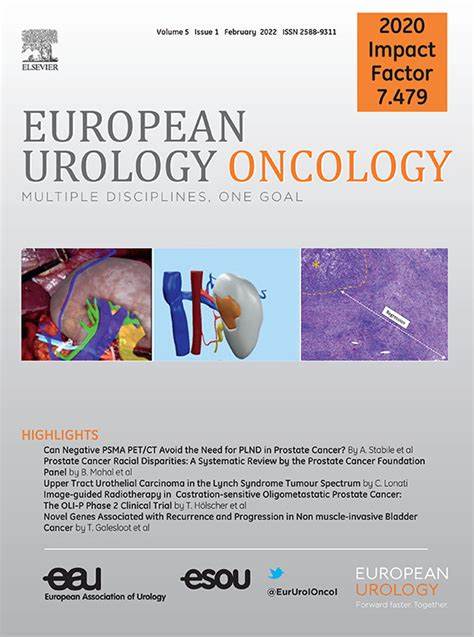Impact of Histological Subtypes/Divergent Differentiation on Clinicopathological and Oncological Outcomes for Patients with Upper Tract Urothelial Carcinoma Treated with Radical Nephroureterectomy: A Comprehensive Updated Systematic Review and Meta-analysis
IF 9.3
1区 医学
Q1 ONCOLOGY
引用次数: 0
Abstract
Background and objective
Upper tract urothelial carcinoma (UTUC) is associated with poor survival. Recent studies have evaluated whether the presence of histological subtypes or divergent differentiation (HS/DD) is associated with worse UTUC prognosis. Our aim was to assess the relationship between HS/DD and clinicopathological features and oncological outcomes for patients with UTUC undergoing radical nephroureterectomy (RNU) without investigating causal pathways.
Methods
A literature search was conducted in September 2024. Patients with UTUC who underwent RNU were included. The main outcomes were differences in clinicopathological features and oncological outcomes between HS/DD and pure urothelial carcinoma (PUC) groups.
Key findings and limitations
We included 22 studies involving 14 407 patients in our review. HS/DD was present in 14% of tumours. In comparison to PUC, the HS/DD group had significantly higher rates of ≥pT3 stage, high-grade tumours, lymph node invasion (LNI), lymphovascular invasion (LVI), and receipt of adjuvant chemotherapy. Pooled results revealed that the HS/DD group had significantly worse cancer-specific survival (CSS) (hazard ratio [HR] 1.65, 95% confidence interval CI] 1.39–1.96), overall survival (OS; HR 1.84, 95% CI 1.52–2.22) ,and recurrence-free survival (RFS; HR 1.64, 95% CI 1.43–1.87). Intravesical RFS (IVRFS) and urothelial RFS (URFS) were comparable between the groups.
Conclusions and clinical implications
Our findings suggest that UTUC with HS/DD is associated with more advanced/aggressive features, such as higher pathological stage and grade, LNI, and LVI. HS/DD is associated with significantly worse CSS, OS, and RFS, but does not predict worse IVRFS or URFS. Therefore, HS/DD detection should prompt extensive treatment and closer follow-up. To improve the quality of recommendations and patient care, well-designed studies with central pathological review are needed.
组织学亚型/分化分化对上尿路癌根治性肾输尿管切除术患者临床病理和肿瘤预后的影响:一项全面更新的系统评价和荟萃分析。
背景与目的:上尿路上皮癌(UTUC)与低生存率相关。最近的研究评估了组织学亚型或分化分化(HS/DD)的存在是否与较差的UTUC预后相关。我们的目的是评估HS/DD与接受根治性肾输尿管切除术(RNU)的UTUC患者的临床病理特征和肿瘤预后之间的关系,而不调查因果途径。方法:于2024年9月进行文献检索。包括接受RNU治疗的UTUC患者。主要结果是HS/DD组与单纯尿路上皮癌(PUC)组的临床病理特征和肿瘤预后的差异。主要发现和局限性:我们纳入了22项研究,涉及14407例患者。14%的肿瘤存在HS/DD。与PUC相比,HS/DD组≥pT3期、高级别肿瘤、淋巴结侵袭(LNI)、淋巴血管侵袭(LVI)和接受辅助化疗的比例显著高于PUC组。合并结果显示,HS/DD组的癌症特异性生存(CSS)(风险比[HR] 1.65, 95%可信区间CI] 1.39 ~ 1.96)、总生存(OS;HR 1.84, 95% CI 1.52-2.22),无复发生存期(RFS;Hr 1.64, 95% ci 1.43-1.87)。两组间膀胱内RFS (IVRFS)和尿路上皮RFS (URFS)具有可比性。结论和临床意义:我们的研究结果表明,合并HS/DD的UTUC与更晚期/侵袭性特征相关,如更高的病理分期和分级、LNI和LVI。HS/DD与较差的CSS、OS和RFS显著相关,但不能预测较差的IVRFS或URFS。因此,检测到HS/DD应及时进行广泛治疗和密切随访。为了提高推荐和患者护理的质量,需要精心设计的研究和中心病理检查。
本文章由计算机程序翻译,如有差异,请以英文原文为准。
求助全文
约1分钟内获得全文
求助全文
来源期刊

European urology oncology
Multiple-
CiteScore
15.50
自引率
2.40%
发文量
128
审稿时长
20 days
期刊介绍:
Journal Name: European Urology Oncology
Affiliation: Official Journal of the European Association of Urology
Focus:
First official publication of the EAU fully devoted to the study of genitourinary malignancies
Aims to deliver high-quality research
Content:
Includes original articles, opinion piece editorials, and invited reviews
Covers clinical, basic, and translational research
Publication Frequency: Six times a year in electronic format
 求助内容:
求助内容: 应助结果提醒方式:
应助结果提醒方式:


